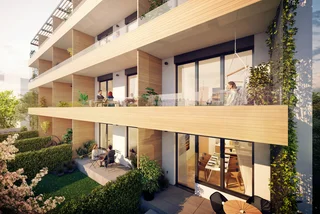Living in Prague’s New Town puts restaurants, cafes and bars, shops, monuments, cultural facilities, schools, and offices all in the palm of your hand. Unfortunately, however, the supply of new apartments in this attractive location is very limited. A project from developer PSN called Rezidence U Sv. Štěpána will offer 42 modern apartments in a historical setting.
A complex of three townhouses on the corner of Na Rybníčku Street is currently undergoing a complete but sensitive renovation that will include the addition of a fifth floor. The historical genius loci of the site will be retained with a mix of Gothic grandeur, classical style, and neo-Renaissance refinement.
Prague’s New Town (Nové Město) didn’t arise by chance. When Emperor Charles IV founded the district in 1348, he had a vision of creating a new center of the Holy Roman Empire, a great city built on the foundations of existing settlements and villages just outside of what is now called Old Town. His grand design included what was the largest square in 14th-century Europe. The original Cattle Market (Dobytčí trh) is now called Karlovo náměstí and, at eight hectares, it is still the largest square in Prague – larger even than Wenceslas Square.
A village called Rybníček (Little Pond) existed in the area as early as the 10th century. The names of the streets Na Rybníčku (On the Little Pond) or V Tůních (In the Pool) still refer to the original settlement. The pond, though, is only a distant memory.
In his city plans, Charles IV reserved a place for the Church of St. Stephen, an early Catholic Church martyr whom he revered. He also kept his relics, as well as those of St. Longinus, a Roman soldier who legends say was at the crucifixion of Jesus.
Rybníček’s Romanesque rotunda, a type of small round church, was originally dedicated to St. Stephen (sv. Štěpán). When the larger Church of St. Stephen was built opposite the rotunda, the latter was rededicated to St. Longinus, and it is still known by that name today. It is one of the oldest monuments in Prague and together with the Church of St. Stephen it forms part of the historical ambiance of the Na Rybníčku location.
Modern apartments with Prague’s historical atmosphere
Residence U Sv. Štěpána bears the charm of history, and this will be reflected in the architecture. For example, the foundations of the oldest part of the project still have masonry from the Chapel of All Saints, a Gothic building that was there from 1406, even before the founding of Prague's New Town. However, unlike the nearby Romanesque rotunda of St. Longinus, this chapel has been lost to time.
Architect Alexander Hellmich designed the complex of the original three townhouses in the late classical style in the mid-19th century. In 1881, Josef Blecha remodeled one of them with a neo-Renaissance facade. In its renovations, PSN will preserve many historical elements, such as the coffered entrance door or the wooden casement windows.
“We see the renovation of the original successful houses as very necessary and meaningful. We can restore their beauty and historical charm, while at the same time bringing modern technology and 21st-century user standards into them,” Štěpán Smrčka, PSN's development director, said.
“Occupants of Residence U Sv. Štěpána will be able to enjoy perfect comfort and thoughtful details alongside the elegance of the classical style and neo-Renaissance refinement," he added.
A total of 42 modern apartments will be built in Residence U Sv. Štěpána, ranging from 1 + kk to 4 + kk and in size from 31 to 139 sqm. Some of them will have terraces, loggias, or balconies. Selected units offer the possibility of heat recovery and cooling. The project also includes cellars and underground parking for seven vehicles.
In the swirl of events
The location of Prague’s historic center, a UNESCO World Heritage Site, is calm despite the pulse of the capital’s heart. New Town residents will find everything they need in the immediate vicinity, from restaurants, cafés, and bars to shops, cultural facilities, schools, and offices.
There are also plenty of historical monuments and Prague's biggest attractions – the National Theatre, the Dancing House, the Emauzy Monastery, the New Town Hall, and Wenceslas Square with the National Museum.
The local sights are refreshed by the greenery of the large park at Karlovo náměstí, which bears the lasting imprint of garden architect František Josef Thomayer. The Vltava River with its famous Náplavka, which has recently been revitalized with renovated cubicles hosting modern businesses, also attracts visitors.
Transport accessibility is also excellent. The nearby Karlovo náměstí with its many tram lines and metro stop B is one of Prague's main arteries, as is the square at I. P. Pavlova with its tram connections and metro C.












 Reading time: 4 minutes
Reading time: 4 minutes 




































